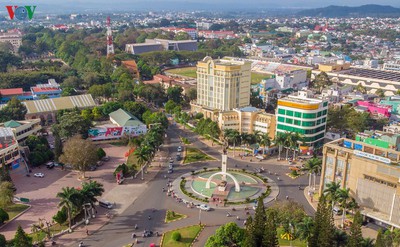 |
| A beautiful lake in Dak Lak. – Photos: Le Trang |
If Kinh, the key ethnic people of Vietnam, historically set up their villages along rivers, villages of ethnic groups in the provinces are mostly by lakes or streams.
Each village in Dak Lak is named after lakes or streams nearby. For example, Ea Nao Lake is in Ea Nao Village and Tara Lake is in Tara Village.
We visited Prong Village, which is around six to seven kilometers from Kmrong Prong waterfront. Along the path from the village to the waterfront are coffee farms and orchards which used to be forests. Kmrong Prong is one of the waterfronts that are still maintained despite urbanization.
In the old days, the founder of village planted trees around the water source to protect it. No one was allowed to build house in the area of the water source.
 |
| A green space seen in Dak Lak. |
The water source is now used for daily routine. Locals use bamboo tubes to take water to their house. The water flows to a lower land shaping a small lake which supplies water to locals. The high trees surrounded the water source help keep the fresh air in the sacred area.
Locals say that the water source is a source of life while the forests form and provide water source to villagers.
To fully discover the water sources there, travelers should cycle around. The cycling trip helps us feel the connection with nature.
Nguyen Quang Binh (SGT)

Buon Ma Thuot – an urban center of the Central Highlands
Buon Ma Thuot, the biggest city in Vietnam’s Central Highlands, covers 370 square kilometers.

Co Thon Village in Buon Ma Thuot city
Co Thon village in Dak Lak is not only the ideal destination for tourists thanks to its reputation as the king village of the Central highlands’ coffee production, but also the symbol for the typical Vietnamese village.